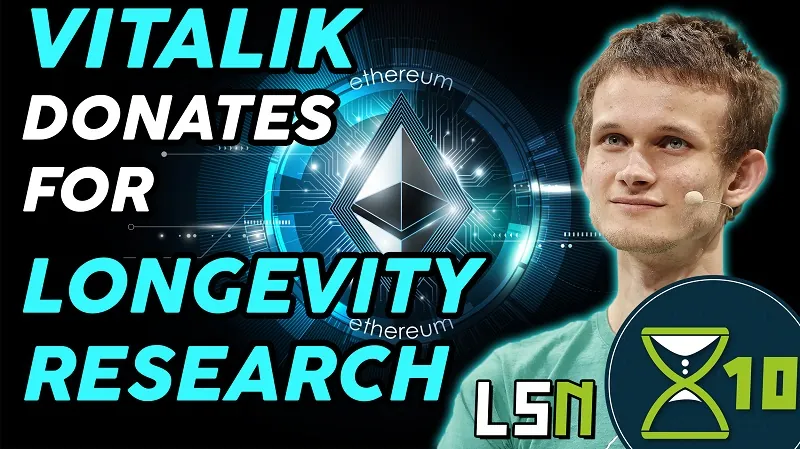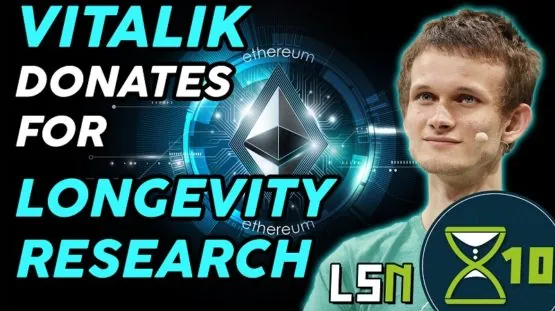This week on Lifespan News, Brent Nally discusses how crypto-billionaire Vitalik Buterin donated around $336 million to longevity research, Lifespan.io launched a new campaign to test rapamycin in humans, people aged 105 and older seem to have better DNA repair mechanisms than others, and a new gene therapy improves the brains of mice with Alzheimer’s.
Further Reading
Vitalik Buterin donates 1000 Etherum to the Methuselah Foundation
Lifespan.io Launches A New Campaign to Test Rapamycin in Humans
People Living 105+ Years Appear to Repair DNA Better
Gene Therapy Improves the Brains of Mice With Alzheimer’s
Script
In this episode of Lifespan News: Billionaire Vitalik Buterin donates around 336 million US dollars to the bio-rejuvenation non-profit Methuselah Foundation; A gene therapy that could improve Alzheimer’s; and people aged 105 and older seem to have better DNA repair mechanisms compared to most other less fortunate humans. You’ll find these stories and more in this episode of Lifespan News.
Welcome to Lifespan News on X10, your source for longevity science updates. I’m your host, Brent Nally. We encourage you to check the description below for links to these stories.
Continuing with our first story, Vitalik Buterin is the billionaire co-creator of the cryptocurrency Ethereum. Vitalik recently transferred Ethereum, ticker trading symbol ETH, and Dogelon Mars, ticker trading symbol ELON, worth around 336 million US dollars to the Methuselah Foundation, a nonprofit that supports efforts in tissue engineering and regenerative medicine therapies. This is not Vitalik’s first donation to a longevity-focused organization. Vitalik donated over two million US dollars worth of Ethereum in 2018 to SENS research foundation, the non-profit co-founded by biogerontologist Dr. Aubrey de Grey. Other organizations have also recently benefitted from Vitalik’s generosity. Vitalik transferred 500 Ethereum and over 50 trillion Shiba Inu coins AKA Shiba Token worth around 1.14 billion US dollars at the time of transaction to the India COVID-Crypto Relief Fund. This more than 50 trillion Shiba Inu coins contribution was more than 5% of total Shiba Inu coins in circulation which sent prices of Shiba Inu coins plummeting by about 50%. Shiba Inu coin is a cryptocurrency created dubbed “the DOGE killer”, as Shiba Inu coin was modeled after another meme crypto coin Dogecoin that has skyrocketed about 20,000% since the start of 2021, mostly because of Elon Musk constantly tweeting about Dogecoin. Vitalik and Aubrey also joined a livestream on VitaDAO’s YouTube channel on May 13th, 2021 which I watched live and enjoyed. According to VitaDAO’s website, VitaDAO is a decentralized collective funding early stage longevity research. The “DAO” in VitaDAO stands for Decentralized Autonomous Organization. Lifespan.io co-founder and President, Keith Comito, recently published an article about this VitaDAO livestream which you can find a link to in the description below. So, you may be wondering why we’re discussing all this on Lifespan News. It’s because there’s a lot of cryptocurrency enthusiasts who are also healthy life extension enthusiasts and vice versa; heck I’m one of them, and the bio-rejuvenation industry could certainly benefit from much more funding. Plus, it’s not every day that a single person donates over a billion US dollars for general healthcare purposes and also separately donates hundreds of millions of US dollars for a bio-rejuvenation focused charity. Hey Vitalik, please consider donating some doge meme crypto and/or Ethereum or, heck, any other form of money to our parent 501(c)(3) charity: Lifespan Extension Advocacy Foundation or LEAF. After all, we’re not only trying to make humanity more healthy, but we’re also huge supporters of the Dog Aging Project. So while this story probably seems weird and even puzzling to many people, I believe cryptocurrencies will continue to gain popularity over time. The future may be weirder than you think.
For our next story, if you got inspired by Vitalik’s generosity, then maybe consider supporting another longevity initiative. Lifespan.io has recently launched a new crowdfunding campaign to support longevity research. The new campaign will be funding a large human trial, the Participatory Evaluation of Aging with Rapamycin for Longevity Study, or PEARL. Rapamycin is a drug well known for its longevity benefits in mice, and this trial aims at finding out whether there’s similar benefits in humans. The trial will follow up to 200 participants over 12 months testing four different Rapamycin dosing regimens. It will be double-blind, randomized, placebo-controlled and registered with clinicaltrials.gov. Follow the link in the description below to learn more and make a donation. Don’t forget to share this news with your friends, to help the campaign reach its goals as soon as possible!
By the way, Lifespan News is released every Tuesday at noon Eastern Time, while our other science and advocacy X10 videos are released every other Monday also at noon Eastern Time. We normally share 5 stories on Lifespan News but this episode only has 4 stories. We’re not short-changing you though. We will release a stand-alone Lifespan News story later this week so be on the lookout for it. Now back to the news.
People living 105+ years appear to have a genetic makeup that allows them to repair their DNA better than most people, according to a new study. The researchers compared the genomes of 81 people aged 105 or older with those of 36 healthy people with an average age of 68. The researchers found five common genetic alterations to the genes COA1 and STK17A that were prevalent in the 105+ group. STK17A is involved in cells destroying themselves in response to DNA damage or high reactive oxygen species levels. COA1 mediates communication between the nucleus and the mitochondria. The researchers also found that the 105+ people had fewer mutations in six of the seven genes they examined. The researchers therefore concluded that efficient DNA repair and low mutational burden are key contributors to these individual’s longevity.
For our final story, gene therapy improves the brains of mice with Alzheimer’s. Upregulating a single protein was sufficient to improve learning, memory, and neuronal morphology in a mouse model of Alzheimer’s disease. Decreased expression of the Caveolin-1 gene is associated with learning and memory deficits in transgenic Alzheimer’s mice. Cav-1 is a scaffolding protein that helps hold together assemblies of proteins in cell membranes known as membrane/lipid rafts. The researchers increased the expression of Cav-1 in hippocampal neurons via gene therapy. The researchers controlled the gene’s expression by engineering it to be expressed only in the presence of synapsin, which is found nearly exclusively in neurons. A viral vector carrying the gene was injected into the hippocampi of three-month old mice. This resulted in high levels of Cav-1 expression throughout their life. The mice were tested at 9 and 11 months, the age when this strain is expected to show Alzheimer’s-like symptoms. The researchers showed that the treatment was able to significantly rescue learning and memory abilities that were impaired in the controls. The structure of the membrane/lipid rafts was also normal, as were several markers of neuronal function. These beneficial outcomes were not due to reduced Amyloid beta and tau levels. The researchers note that this means the approach may produce even better results in combination with treatments that target Amyloid beta and tau pathologies.
That’s all the news for this video. Is there a recent life extension story that we haven’t covered yet that you think we should have? And what was your favorite story from this episode? Let us know what you think in the comments below. We really appreciate it and we look forward to seeing you in the next episode at least as healthy as you are now.
Next video:
DHE reduces inflammation, senescence in intervertebral discs. Recent research shows that a natural herbal compound reduces senescence and intervertebral disc degeneration in mice. Intervertebral discs are shock-absorbing tissues located between our vertebral bones that allow the spine to bend. They degrade with age, leading to complaints such as back pain, degenerative disc disease, and herniated discs. Based on the hypothesis that an inflammatory response to cellular senescence is to blame for disc degeneration, researchers investigated whether the anti-inflammatory dehydrocostus lactone, or DHE, could help. The researchers tested the effect of DHE on cells from the gel-like region at the center of the discs, which are known to contribute to local inflammation. While high doses proved cytotoxic, the researchers found that low doses were beneficial. DHE reduced the inflammatory response when the cells were exposed to an inflammatory cytokine. The researchers also tested DHE in a mouse model of spinal instability. DHE-treated mice had better spinal structure and less inflammation. While DHE reduced inflammation, the team did not measure whether DHE affected senescence. Though more research will be needed to clarify this, the anti-inflammatory effect alone warrants consideration as a potential treatment for disc degradation.



